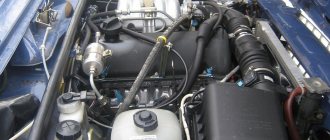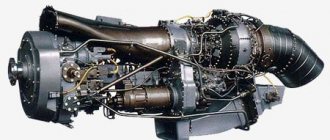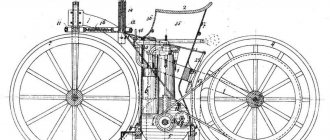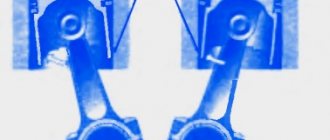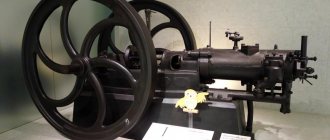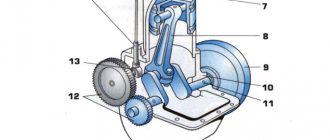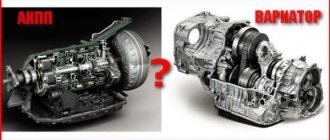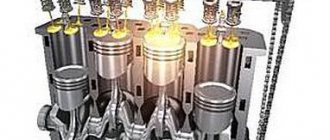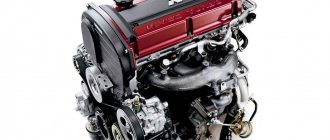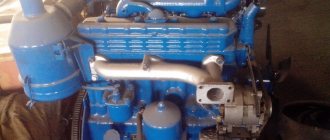Nowadays, the automotive industry has reached a level of development where, without basic scientific principles, it is difficult to achieve improvements in the design of traditional internal combustion engines. This forced designers to increasingly pay attention to projects for alternative power plants. Engineering centers and automakers approached this issue differently. Some focused on creating adaptations for serial production of electric and hybrid powertrain models. Others are investing in developing engines that use fuel from renewable sources.
One of the promising sources of mechanical energy for cars is the external combustion engine, developed by Scottish native Robert Stirling a couple of centuries ago. The operating principle of the Stirling external combustion engine is very different from the usual internal combustion engine. But for some time after development, it was safely forgotten.
History of creation
In 1816, Scottish native Robert Stirling patented a heat engine, which today is named after its creator. However, the very idea of hot air engines was not invented by him. But the first conscious project to create such a unit was implemented by Stirling. He improved the system by adding a purifier, which in the technical literature was called a heat exchanger. Thanks to this, the performance of the motor has greatly increased by keeping it warm. This model was considered the most durable for that time, since it never exploded.
Despite such rapid success in promoting the model, at the beginning of the twentieth century, further development of the external combustion engine was abandoned due to its cost in favor of the internal combustion engine.
Stirling engine: concept, design, principle of operation
Home page » Stirling engine: concept, design, principle of operation
It is logical to consider engines as a product of the industrial revolution. The first “swallow” was steam structures running on coal. Cleaner and more efficient gasoline engines followed. The most modern designs are jet engines. The basic concept of this design is obvious - the difference between high and low temperature. This concept hasn't really changed in a couple of hundred years, despite the improvements that have been made. Meanwhile, among all the variety of existing concepts, the Stirling engine (author Robert Stirling 1816), which resembles a steam system, but does not involve the use of steam, attracts attention. Let's take a closer look at this design.
Stirling engine: principle of operation and modifications
The operating principle of any heat engine is that considerable mechanical effort is required to produce gas in an expanded state. An illustrative example is the experiment with two pans, according to which they are filled with cold and hot water. Place a bottle with a screwed cap in cold water. After this, the bottle is transferred to hot water. With this movement, the gas in the bottle performs mechanical work and pushes the cork out of the neck. The first model of an external combustion engine worked on exactly the same principle. However, later the creator realized that part of the heat generated could be used for heating. The productivity of the unit only increased from this. A little later, an engineer from Sweden, Erickson, improved the design, putting forward the idea of cooling and heating gas at constant pressure instead of volume. This allowed the engine to “move up the career ladder” and begin to be used in mines and printing houses. The unit turned out to be too heavy for crews and vehicles.
The figure clearly shows the duty cycle of a Stirling engine.
How does a Stirling engine work? It converts thermal energy supplied from outside into useful mechanical work. This process occurs due to changes in the temperature of gas or liquid circulating in a closed volume. In the lower part of the unit, the working substance heats up, increases in volume and pushes the piston upward. Hot air enters the top of the engine and is cooled by a radiator. The pressure of the working fluid decreases, and the piston is lowered to repeat the entire cycle. The system is completely sealed, due to which the working substance is not consumed, but only moves within the cycle.
In addition, there are open-cycle motors in which flow control is realized using valves. These models are called the Erickson engine. In general, the operating principle of an external combustion engine is similar to an internal combustion engine. At low temperatures, compression occurs in it and vice versa. Heating is carried out in different ways. Heat in an external combustion engine is supplied through the cylinder wall from the outside. Stirling came up with the idea of using a periodic temperature change with a displacement piston. This piston moves gases from one cavity of the cylinder to another. At the same time, low temperatures are constantly maintained on one side, and high on the other. When the piston moves upward, gas moves from the hot to the cold cavity. The displacer system in the engine is connected to a working piston, which compresses the gas when cold and allows it to expand when warm. Useful work is done precisely due to compression at lower temperatures. Continuity is ensured by the crank mechanism. There are no special boundaries between the stages of the cycle. Thanks to this, the efficiency of the Stirling engine does not decrease.
This is interesting: Photos of Lexus IS250 tuning
Some engine details
In theory, any heat source (sun, electricity, fuel) can supply energy to an external combustion engine. The operating principle of the engine body is to use helium, hydrogen or air. The ideal cycle has the highest possible thermal efficiency. The efficiency is from 30 to 40%. An efficient regenerator can provide higher efficiency. Integrated heat exchangers provide regeneration, exchange and cooling in modern engines. Their advantage is that they work without oils. In general, the engine requires little lubrication. The average pressure in the cylinder varies from 10 to 20 MPa. A good sealing system and the possibility of oil getting into the working cavities are necessary.
According to theoretical calculations, the efficiency of the Stirling engine is highly dependent on temperature and can even reach 70%. The very first engine samples implemented in metal had low efficiency, since the coolant options were ineffective and limited the maximum heating temperature, and there were no structural materials resistant to high pressure. In the second half of the 20th century, an engine with a rhombic drive during tests exceeded 35% efficiency with a water coolant and a temperature of 55 degrees Celsius. Improving the design in some experimental samples made it possible to achieve almost 39% efficiency. Almost all modern gasoline engines with similar power have an efficiency of 28 - 30%. Turbocharged diesels reach about 35%. The most modern Stirling engines, developed by Mechanical Technology Inc in the USA, show efficiency of up to 43%.
After the development of heat-resistant ceramics and other innovative materials, it will be possible to further increase the temperature of the environment. Efficiency can even reach 60% under such conditions.
There are several modifications of the Stirling external combustion engine.
Modification "Alpha"
Such an engine consists of hot and cold separate power pistons located in their own cylinders. Heat is supplied to the cylinder with the hot piston, and the cold one is located in the cooling heat exchanger.
Modification "Beta"
In this version of the engine, the cylinder in which the piston is located is heated on one side and cooled on the other. A displacer and a power piston move inside the cylinder. The displacer is designed to change the volume of the working gas. The regenerator returns the cooled working substance to the heated cavity of the engine.
Modification "Gamma"
The entire simple design of the Gamma modification is made of two cylinders. The first one is completely cold. A power piston moves in it. And the second one is cold only on one side, and heated on the other. It serves to move the displacer mechanism. The cold gas circulation regenerator in this modification can be common to both cylinders and be included in the design of the displacer.
Principle of operation
The motor operates in thermodynamic cycles, in which compression and expansion occur at different temperatures. In this case, regulation of the flow of the working fluid is realized due to changing volume (or pressure - depending on the model). This is the operating principle of most of these machines, which may have different functions and design designs. Engines can be piston or rotary. Machines with their installations work as heat pumps, refrigerators, pressure generators, and so on.
In addition, there are open-cycle motors, where flow control is realized through valves. They are called Erickson engines, in addition to the common name Stirling. In an internal combustion engine, useful work is carried out after preliminary compression of air, injection of fuel, heating of the resulting mixture mixed with combustion and expansion.
The Stirling engine operates on the same principle: compression occurs at low temperatures, and expansion occurs at high temperatures. But heating is carried out differently: heat is supplied through the cylinder wall from the outside. That's why it got the name external combustion engine. Stirling used periodic temperature changes with a displacement piston. The latter moves gas from one cavity of the cylinder to another. On the one hand, the temperature is constantly low, and on the other, high. When the piston moves up, gas moves from the hot to the cold cavity, and downwards it returns to the hot cavity. First, the gas gives a lot of heat to the refrigerator, and then from the heater it receives the same amount as it gave. A regenerator is placed between the heater and the refrigerator - a cavity filled with material to which the gas gives off heat. When the flow reverses, the regenerator returns it.
The displacer system is connected to a working piston, which compresses the gas when cold and allows it to expand when warm. Due to compression at a lower temperature, useful work occurs. The entire system goes through four cycles with intermittent movements. The crank mechanism ensures continuity. Therefore, there are no sharp boundaries between the stages of the cycle, and the efficiency of the Stirling engine does not decrease.
Considering all of the above, the conclusion suggests itself that this engine is a piston machine with an external heat supply, where the working fluid does not leave the enclosed space and is not replaced. Drawings of the Stirling engine well illustrate the device and the principle of its operation.
Advantages of an external combustion engine
This type of engine is unpretentious in terms of fuel, since the basis of its operation is the temperature difference. What caused this difference is not particularly important. The Stirling engine has a simple design and does not require additional systems and attachments (starter, gearbox). Some features of the engine design guarantee a long service life: the engine can operate continuously for approximately one hundred thousand hours. Another major advantage of an external combustion engine is its noiselessness. This is due to the fact that there is no detonation in the cylinders and there is no need to remove exhaust gases. The “Beta” modification especially stands out in this parameter. Its design is equipped with a diamond-shaped crank mechanism, which ensures the absence of vibrations during operation. And finally, environmental friendliness. There are no processes in the engine cylinders that can negatively affect the environment.
This is interesting: How to change silent blocks on Honda-SRV and Honda-Fit
By choosing alternative heat sources (solar energy), the Stirling engine turns into a type of environmentally friendly power unit.
Pros of the Stirling engine
The main advantage of this type of power unit is that it can operate on different types of fuel. In practice, the following was tested: first gasoline was supplied to the outer chamber of the device, then diesel, then methane, then crude oil and vegetable oil. All this was done without stopping the engine and it continued to work successfully.
Also, a big advantage compared to conventional two-stroke or four-stroke internal combustion engines is that the Stirling engine does not require additional attachments, such as a gas distribution mechanism, gearbox, or starter.
The service life of the Stirling engine is more than 100 thousand hours of operation without stopping.
An important plus is the quiet operation. Such an engine does not require exhaust gas removal. There can be no engine detonation and there is virtually no vibration.
Beta engine design
The advantage for the environment is an engine that does not pollute the environment, which means it is a guarantee of health.
Disadvantages of an external combustion engine
Mass production of such engines is currently impossible. The main problem is the material consumption of the structure. Cooling the engine working fluid requires the installation of large-volume radiators. As a result, the dimensions increase. The use of complex types of working fluid such as hydrogen or helium raises the issue of engine safety. Thermal conductivity and temperature resistance must be at a high level. Heat is supplied to the working volume through heat exchangers. Thus, some of the heat is lost along the way. In the manufacture of heat exchangers, it is necessary to use heat-resistant metals. In this case, metals must be resistant to high pressure. All these materials are expensive and take a long time to process. The principles of changing the modes of an external combustion engine are very different from traditional ones. The development of special control devices is required. The change in power is caused by a change in pressure in the cylinders and the phase angle between the displacer and the power piston. You can also change the capacity of the cavity with the working fluid.
Advantages and disadvantages of Stirling engines
A clear advantage of the Stirling engine is its greater efficiency compared to the same steam systems. The need for boilers - technologically dangerous structures - is eliminated; there is no need to store water and create complex systems for opening / closing valves.
It should be noted: due to the absence of complex valve systems, Stirling engines are quieter than steam designs. Considering the possible use of energy obtained from sources other than fuel combustion, these designs are environmentally friendly systems. Supports operation on all types of fuel.
Potential downsides include a relatively slow start-up. It usually takes time for the heat exchanger and flywheel to warm up to get the system up to operating speed.
Stopping processes are also quite difficult. The designs require large radiators for effective heat removal, which somewhat limits their use in some cases.
How to repair a Xerox Phaser 3140 printer yourself
Outtempering: technology of heat treatment of ferrous metals
How to work with bicycle gears?
Examples of implementation of external combustion engines in cars
Operable models of such an engine were released, despite all the manufacturing difficulties. In the 50s of the 20th century, automobile companies became interested in this type of power unit. The sales of Stirling engines in cars were mainly carried out by Ford Motor Company and Volkswagen Group. The Swedish company UNITED STIRLING developed such an engine in which the developers tried to use serial units and components (crankshaft, connecting rods) more often. A four-cylinder V-engine was developed with a specific mass of 2.4 kg/kW. A compact diesel has a similar weight. They tried to install the engine on seven-ton cargo vans.
The most notable success was the Philips 4-125DA, available for installation in passenger cars. The engine's operating power was 173 horsepower. The dimensions were not much different from a conventional gasoline internal combustion engine.
General Motors has developed an eight-cylinder V-shaped external combustion engine with a serial crank mechanism. In 1972, a limited version of Ford Torino cars was equipped with such an engine. Moreover, fuel consumption has decreased by as much as 25% compared to previous models. Today, several foreign companies are trying to improve the design of this engine in order to adapt it for mass production and installation in passenger cars.
Operating principle
Scheme of a tandem steam engine: 1 - piston, 2 - piston rod, 3 - slider, 4 - connecting rod, 5 - crank, 6 - shaft, 7 - flywheel, 8 - sliding valve, 9 - centrifugal regulator Scheme of operation of a double-acting steam engine
For To operate a steam engine, a steam boiler is required. The expanding steam presses on the piston or on the blades of the steam turbine, the movement of which is transmitted to other mechanical parts.
The operating principle of a piston steam engine is shown in the illustration. The work of the piston 1 through the rod 2, slider 3, connecting rod 4 and crank 5 is transmitted to the main shaft 6, which carries a flywheel 7, which serves to reduce the uneven rotation of the shaft. An eccentric sitting on the main shaft, with the help of an eccentric rod, moves spool 8, which controls the intake of steam into the cylinder cavity. The steam from the cylinder is released into the atmosphere or enters a condenser. To maintain a constant number of shaft revolutions with a changing load, steam engines are equipped with a centrifugal regulator 9, which automatically changes the cross-section of the passage of steam entering the steam engine ( throttle control
, shown in the figure), or the filling cut-off point (
quantitative regulation
).
The piston forms one or two cavities of variable volume in the cylinder of a steam engine, in which processes of compression and expansion occur, which is shown by pressure dependence curves p
from the volume
V
of the indicated cavities.
These curves form a closed line in accordance with the thermal cycle in which the steam engine operates between pressures p1
and
p2
, as well as volumes
V1
and
V2
. The primary piston engine is designed to convert the potential thermal energy (pressure) of water vapor into mechanical work. The working process of a steam engine is determined by periodic changes in the elasticity of steam in the cavities of its cylinder, the volume of which changes during the reciprocating movement of the piston. Steam entering the cylinder of a steam engine expands and moves the piston. The reciprocating movement of the piston is converted by a crank mechanism into rotational movement of the shaft. Steam inlet and outlet are carried out by a steam distribution system. To reduce heat losses, the cylinders of a steam engine are surrounded by a steam jacket.
The moments of the beginning and end of the processes of expansion and compression of steam give the four main points of the real cycle of a steam engine: volume Ve
, determined by point 1 of the beginning or advance of the intake;
volume of the inlet or filling end E
, determined by filling cut-off point 2;
volume of pre-release or end of expansion Va
, determined by pre-release point 3;
volume of compression Vc
, determined by point 4 of the beginning of compression. In a real steam engine, the listed volumes are recorded by steam distribution elements.
Efficiency
The coefficient of performance (COP) of a heat engine can be defined as the ratio of useful mechanical work to the expended amount of heat contained in the fuel. The rest of the energy is released into the environment in the form of heat.
The efficiency of a heat engine is:
η th = W out Q in {\displaystyle \eta _{th}={\frac {W_{out}}{Q_{in}}}} ,
where Wout is mechanical work, J; Qin is the amount of heat expended, J.
A heat engine cannot have an efficiency greater than that of the Carnot cycle, in which an amount of heat is transferred from a heater at a high temperature to a refrigerator at a low temperature. The efficiency of an ideal Carnot heat engine depends solely on the temperature difference, and the absolute thermodynamic temperature is used in the calculations. Therefore, steam engines require the highest possible temperature T1 at the beginning of the cycle (achieved, for example, using superheating) and the lowest possible temperature T2 at the end of the cycle (for example, using a condenser):
η th ≤ 1 − T 2 T 1 {\displaystyle \eta _{th}\leq 1-{\frac {T_{2}}{T_{1}}}}
A steam engine releasing steam to the atmosphere will have a practical efficiency (including the boiler) of 1 to 8%, but an engine with a condenser and expansion of the flow path can improve the efficiency to 25% or even more. A thermal power plant with a steam superheater and regenerative water heating can achieve an efficiency of 30-42%. Combined cycle power plants, in which fuel energy is first used to drive a gas turbine and then a steam turbine, can achieve efficiencies of 50-60%. At thermal power plants, efficiency is increased by using partially exhausted steam for heating and production needs. In this case, up to 90% of the fuel energy is used and only 10% is dissipated uselessly in the atmosphere.
Such differences in efficiency occur due to the characteristics of the thermodynamic cycle of steam engines. For example, the greatest heating load occurs in winter, so the efficiency of a thermal power plant increases in winter.
One of the reasons for the decrease in efficiency is that the average temperature of the steam in the condenser is slightly higher than the ambient temperature (the so-called temperature difference is formed). The average temperature difference can be reduced through the use of multi-pass capacitors. The use of economizers, regenerative air heaters and other means of optimizing the steam cycle also increases efficiency.
A very important property of steam engines is that isothermal expansion and compression occur at constant pressure, specifically at the pressure of the steam coming from the boiler. Therefore, the heat exchanger can be of any size, and the temperature difference between the working fluid and the cooler or heater is about 1 °C. As a result, heat losses can be minimized. For comparison, temperature differences between the heater or cooler and the working fluid in Stirling can reach 100 °C.
Advantages and disadvantages
| This section is missing references to information sources. Information must be verifiable, otherwise it may be questioned and deleted. You may edit this article to include links to authoritative sources. This mark was set on October 29, 2014 . |
| Check neutrality. There should be details on the talk page. |
The main advantage of steam engines as external combustion engines is that, due to the separation of the boiler from the steam engine, almost any type of fuel (heat source) can be used - from dung to a chain reaction of uranium fission.
This distinguishes them from internal combustion engines, each type of which requires the use of a specific type of fuel. This advantage is most noticeable in the use of nuclear energy, since a nuclear reactor is unable to generate mechanical energy, but only produces heat, which is used to generate steam to drive steam engines (usually steam turbines). In addition, there are other heat sources that cannot be used in internal combustion engines, such as solar energy. An interesting direction is the use of energy from temperature differences in the World Ocean at different depths.
Similar properties are also found in other types of external combustion engines, such as the Stirling engine, which can provide very high efficiency, but have significantly greater weight and size than modern types of steam engines.
Steam locomotives perform well at high altitudes, since their operating efficiency does not decrease, but, on the contrary, increases due to low atmospheric pressure. Steam locomotives are still used in the mountainous regions of Latin America and China, despite the fact that in the lowlands they have long been replaced by more modern types of locomotives.
In Switzerland (Brienz Rothorn) and Austria (Schafberg Bahn), new steam locomotives using dry steam have proven their efficiency. This type of locomotive was developed based on the Swiss Locomotive and Machine Works (SLM) models of the 1930s, with many modern improvements such as the use of roller bearings, modern thermal insulation, combustion of light petroleum fuels, improved steam lines, etc. As a result, such locomotives have 60% lower fuel consumption and significantly lower maintenance requirements [ clarify
].
The economic qualities of such locomotives are comparable to modern diesel and electric locomotives[ clarify
].
In addition, steam locomotives are much lighter than diesel and electric ones, which is especially important for mountain railways.
A special feature of steam engines is that they do not require a transmission, transmitting power directly to the wheels.
An important advantage of piston steam engines is the preservation of maximum torque at any speed, down to the very minimum. This gives steam vehicles dynamics that are unattainable for normal vehicles with an internal combustion engine - overcoming slopes at any speed, extremely slow travel, smooth running without jerking, etc., while for trackless vehicles it provides exceptional off-road capability and is not prone to slipping.
Due to their high torque, piston steam engines also do not need a gearbox or reduction gear, transmitting the force directly to the wheels or to the differential of the drive axle.
The simplicity of the device, gentle temperature conditions and low speeds characteristic of piston steam engines significantly increase their service life, which ensures their high reliability and durability.
A piston steam engine is capable of withstanding high overloads for a long time (up to 100%), which internal combustion engines are not capable of.
A piston steam engine does not require maintaining idle speed and consumes steam strictly proportional to the load, which significantly improves its efficiency. In modern automated high-pressure boilers, the fuel supply can be turned off as often as desired as soon as steam flow stops, and restarting occurs almost instantly.
A piston steam engine is almost silent.
Combustion of fuel in a special chamber at normal pressure allows complete oxidation without the formation of toxic products. Using geothermal energy, solar energy or other natural sources can make a steam engine completely environmentally friendly. As a result, the environmental potential of steam engines is much higher than that of internal combustion engines.
conclusions
If the shortcomings of the external combustion engine are eliminated, then this type of power unit will replace the internal combustion engine and even electric motors. But due to the high cost of materials, the complexity of their processing and the cumbersome design, the external combustion engine cannot yet be mass produced. Perhaps someday a cheap heat-resistant and pressure-resistant material will be developed that will be used in the manufacture of the Stirling engine, but for now the entire structure costs manufacturers much more than a conventional internal combustion engine. Good luck and easy travels!
Engine operating principle
To understand how a Stirling engine works, let’s understand the structure and frequency of the unit’s phenomena. The mechanism converts the heat received from the heater located outside the product into a force on the body. The whole process occurs due to a temperature difference in the working substance located in a closed circuit.
The principle of operation of the mechanism is based on expansion due to heat. Immediately before expansion, the substance in a closed loop is heated. Accordingly, before being compressed, the substance is cooled. The cylinder itself (1) is enveloped in a water jacket (3), and heat is supplied to the bottom. The piston doing the work (4) is placed in a sleeve and sealed with rings. Between the piston and the bottom there is a displacement mechanism (2), which has significant gaps and moves freely. The substance, located in a closed loop, moves throughout the chamber volume due to the displacer. The movement of matter is limited in two directions: the bottom of the piston, the bottom of the cylinder. The movement of the displacer is provided by a rod (5), which passes through the piston and operates due to an eccentric with a delay of 90° in comparison with the piston drive.
- Position "A":
The piston is located in the lowest position, the substance is cooled by the walls.
- Position "B":
The displacer occupies the upper position, moves, passes the substance through the end slots to the bottom, and cools itself. The piston remains motionless.
- Position "C":
The substance receives heat, under the influence of heat it increases in volume and lifts the expander with the piston upward. The work is done, after which the displacer sinks to the bottom, pushing out the substance and cooling.
- Position "D":
The piston goes down, compresses the cooled substance, and useful work is performed. The flywheel serves as an energy accumulator in the design.
The considered model does not have a regenerator, so the efficiency of the mechanism is not high. The heat of the substance after work is done is transferred to the coolant using the walls. The temperature does not have time to decrease by the required amount, so the cooling time is prolonged and the motor speed is low.
STIRLINGS
From the past to the future! In 1817, the Scottish priest Robert Stirling received... a patent for a new type of engine, which was later named, like Diesel engines, after the inventor - Stirling. The parishioners of a small Scottish town had long been looking sideways at their spiritual shepherd with obvious suspicion. Still would! The hissing and rumble that penetrated the walls of the barn, where Father Stirling often disappeared, could confuse not only their God-fearing minds. There were persistent rumors that the barn contained a terrible dragon, which the holy father tamed and fed with bats and kerosene.
But Robert Stirling, one of the most enlightened people in Scotland, was not embarrassed by the hostility of his flock. Worldly affairs and worries occupied him more and more, to the detriment of serving the Lord: they carried away the pastor... cars.
At that time, the British Isles were experiencing an industrial revolution: manufacturing was rapidly developing. And the clergy do not remain indifferent to the enormous income that the new method of production promises.
With the blessing of the church and not without the help of manufacturers, several Stirling machines were built, and the best of them, 45 hp. s., worked for three years at a mine in Dundi.
Further development of Stirlings was delayed: in the 60s of the last century, the new Erickson engine entered the arena.
Both designs had a lot in common. These were external combustion engines. In both cars, the working fluid was air, and in both cars, the basis of the engine was a regenerator, passing through which the hot exhaust air gave off all the heat. A fresh portion of air, seeping through a dense metal mesh, took away this heat before entering the working cylinder.
According to the diagram in Figure 1, you can see how the air through the suction pipe 10 and valve 4 enters the compressor 3, is compressed and exits through valve 5 into the intermediate tank. At this time, the spool 8 closes the exhaust pipe 9, and the air through the regenerator enters the working cylinder 1, heated by the firebox 11. Here the air expands, performing useful work, which is partly aimed at lifting the heavy piston, partly at compressing cold air in compressor 3. As the piston descends, it pushes exhaust air through the regenerator 7 and spool 8 into the exhaust pipe. When the piston is lowered, a fresh portion of air is sucked into the compressor.
Rice. 1. Diagram of an external combustion engine (Erickson):
1 — working cylinder, 2 — piston; 3 - compressor; 4 - suction valve; 5 - discharge valve; 6 - intermediate tank; 7 - regenerator; 8 — bypass valve; 9 — exhaust pipe; 10 - suction pipe; 11 - firebox.
Both designs were not economical. But for some reason there were more problems with the Scotsman’s engine, and it was less reliable than Erickson’s engine. Perhaps that is why they overlooked one very important detail: with equal power, the Stirling engine was more compact. In addition, it had a significant advantage in thermodynamics...
Compression, heating, expansion, cooling - these are the four main processes necessary for the operation of any heat engine. Each of them can be carried out in different ways. For example, heating and cooling of gas can be carried out in a closed cavity of constant volume (isochoric process) or under a moving piston at constant pressure (isobaric process). Compression or expansion of a gas can occur at a constant temperature (isothermal process) or without heat exchange with the environment (adiabatic process). By making closed chains of various combinations of such processes, it is not difficult to obtain theoretical cycles according to which all modern heat engines operate. Let's say a combination of two adiabats and two isochores form the theoretical cycle of a gasoline engine. If you replace the isochore, through which the gas is heated, with an isobar, you get a diesel cycle. Two adiabats and two isobars will give the theoretical cycle of a gas turbine. Among all conceivable cycles, the combination of two adiabats and two isotherms plays a particularly important role in thermodynamics, since the engine with the highest efficiency should operate on such a cycle - the Carnot cycle.
If in the Stirling engine the heat was supplied along isochores, then in Erickson this process occurred along an isobar, and the processes of compression and expansion proceeded along isotherms.
At the beginning of this century, Erickson engines of low power (about 10-20 hp) found use in various countries. Thousands of such installations worked in factories, printing houses, mines and mines, turning machine shafts, pumping water, raising elevators. They were also known in Russia under the name “warmth and strength”.
Attempts were made to make a large marine engine, but the test results discouraged not only skeptics, but also Erickson himself. Contrary to the prophecies of the first, the ship “moved from its place” and even crossed the Atlantic Ocean. But the inventor’s expectations were also deceived: four gigantic engines instead of 1000 hp. With. developed only 300 hp. With. Coal consumption was the same as that of steam engines. In addition, the bottoms of the working cylinders burned through at the end of the voyage, and in England the engines had to be removed and secretly replaced with an ordinary steam engine. To top off all the misfortunes, on the way back to America, the ship suffered an accident and the entire crew perished.
Rice. 2. Scheme of operation of a modern Stirling engine:
1 - working piston 2 - displacer piston; 3 - cooler; 4 - heater; 5 - regenerator; 6 - cold space; 7 - hot space.
Abandoning the idea of building high-power “caloric machines,” Erickson began mass production of small engines. The fact is that the level of science and technology of that time did not allow us to design and build an economical and powerful machine.
But the main blow to Erickson came from the inventors of the internal combustion engine. The rapid development of diesel engines and carburetor engines forced a good idea into oblivion.
...A century has passed. In the 1930s, one of the military departments commissioned the development of a 200-400 watt power plant for a camping radio station. Moreover, the engine must be omnivorous, that is, run on any type of fuel.
The company's specialists set to work thoroughly. We started by researching various thermodynamic cycles and, to our surprise, discovered that theoretically the most economical was the long-forgotten Stirling engine.
The war suspended research, but in the late 40s work was continued. And then, as a result of numerous experiments and calculations, a new discovery was made - a closed circuit in which there is a pressure of about 200 atm. the working fluid circulated (hydrogen or helium, as having the lowest viscosity and the highest heat capacity). True, having closed the cycle, the engineers were forced to take care of artificial cooling of the working fluid. This is how a cooler appeared, which the first external combustion engines did not have. And although the heater and cooler, no matter how compact they are, make the stirling heavier, they give it one very important quality.
Isolated from the external environment, they are practically independent of it. Stirling can operate from any heat source anywhere: under water, underground, in space - that is, where internal combustion engines that require air cannot work. In such conditions, it is basically impossible to do without heaters and coolers that transfer heat through the wall. And this is where the Stirlings beat their rivals even in terms of weight. The first prototypes had a specific gravity per unit of power of the order of 6-7 kg per liter. s., like marine diesel engines. Modern stirlings have an even lower ratio - 1.5-2 kg per liter. With. They are even more compact and lightweight.
So, the circuit has become double-circuit: one circuit with the working agent and the second for heat supply; this made it possible to increase energy consumption to 200 liters. With. per liter of working volume, and efficiency - up to 38-40 percent. For comparison: modern
new diesel engines have efficiency 34-38 percent, and carburetor engines - 25-28. In addition, the combustion process of Stirling fuel is continuous, and this sharply reduces toxicity - in terms of carbon monoxide output by 200 times, and in terms of nitrogen oxide - by 1-2 orders of magnitude. This is where, perhaps, one of the radical solutions to the problem of urban air pollution lies.
The working part of a modern Stirling is a closed volume filled with working gas (Fig. 2). The upper part of the volume is hot, it is continuously heated. The lower one is cold, constantly cooled by water. In the same volume there is a cylinder with two pistons: a displacer and a working one. When the piston goes up, the gas volume is compressed; down - expands. The up and down movement of the piston-displacer produces an alternating distribution of heated and cooled gas. When the displacer piston is in the upper position (in the hot zone), most of the gas is forced into the cold zone. At this time, the working piston begins to move upward and compresses the cold gas. Now the displacer piston rushes down to contact the working piston, and the compressed cold gas is pumped into the hot space. Expansion of heated gas - working stroke. Part of the power stroke energy is stored for subsequent compression of the cold gas, and the excess goes to the engine shaft.
The regenerator is located between the cold and hot spaces. When the expanded hot gas is pumped into the cold part by the movement of the piston-displacer, it passes through a dense bundle of thin copper wires and gives them the heat it contains. During the return stroke, the compressed cold air, before entering the hot part, takes this heat back.
Rice. 3. The device of modern Stirling:
1 - fuel injector; 2 — exhaust of cooled gases, 3 — air heater; 4 - outlet of hot gases; 5 - hot space; 6 - regenerator; 7 - cylinder; 8 — cooler tubes; 9 - cold space; 10 - working piston; 11 — rhombic drive; 12 - combustion chamber; 13 — heater tubes; 14 — piston-displacer; 15 — air intake for fuel combustion; 16 - buffer cavity.
Of course, in a real car everything does not look so simple (Fig. 3). It is impossible to quickly heat gas through a thick cylinder wall; this requires a much larger heating surface. That is why the upper part of the closed volume turns into a system of thin tubes heated by the flame of the nozzle. In order to use the heat of the combustion products as fully as possible, the cold air supplied to the injector is preheated by the exhaust gases - this creates a rather complex combustion circuit.
The cold part of the working volume is also a system of tubes into which cooling water is pumped.
Under the working piston there is a closed buffer cavity filled with compressed gas. During the working stroke, the pressure in this cavity increases. The energy stored in this case is sufficient to compress the cold gas in the working volume.
As they improved, the temperature and pressure increased uncontrollably. 800° Celsius and 250 atm. - this is a very difficult task for designers, this is the search for especially durable and heat-resistant materials, the difficult problem of cooling, since the heat generation here is one and a half to two times greater compared to classical engines.
The results of these experiments sometimes lead to the most unexpected findings. For example, experts, while running their engine at idle (without heating), noticed that the cylinder head was very cool. The completely accidentally discovered effect led to a whole series of developments, and ultimately the birth of a new refrigeration machine. Nowadays, such high-performance and small-sized refrigeration units are widely used throughout the world. But let's return to heat engines.
Subsequent events grow like a snowball. In 1958, with the acquisition of licenses by other companies, Stirling stepped overseas. It began to be tested in a variety of areas of technology. A project is being developed to use the engine to power the equipment of spacecraft and satellites. For field radio stations, power plants are created that operate on any type of fuel (with a power of about 10 hp), and have such a low noise level that it cannot be heard for 20 steps.
A demonstration unit operating on twenty types of fuel caused a huge sensation. Without turning off the engine, by simply turning the tap, gasoline, diesel fuel, crude oil, olive oil, and flammable gas were alternately fed into the combustion chamber - and the machine “ate” any “food” perfectly. There were reports in the foreign press about a 2.5 thousand liter engine project. With. with a nuclear reactor. Estimated efficiency 48-50%. All dimensions of the power unit are significantly reduced, which allows the released weight and area to be used for biological protection of the reactor.
Another interesting development is a drive for an artificial heart weighing 600 g and with a power of 13 watts. The weakly radioactive isotope provides it with a virtually inexhaustible source of energy.
The Stirling engine was tested on some cars. In terms of its operating parameters, it was not inferior to the carburetor, and the noise level and toxicity of exhaust gases were significantly reduced.
A car with Stirling can run on any type of fuel, and, if necessary, on melt. Imagine: before entering the city, the driver turns on the burner and melts several kilograms of aluminum oxide or lithium hydride. It drives along city streets “without smoking”: the engine runs on the heat stored in the melt. One of the companies has manufactured a scooter, the tank of which is filled with about 10 liters of molten lithium fluoride. This charge is enough for 5 hours of operation with an engine power of 3 liters. With.
Work on the Stirlings continues. In 1967, a prototype of a pilot plant with a capacity of 400 hp was manufactured. With. per cylinder. A comprehensive program is being carried out, according to which by 1977 it is planned to mass produce engines with a power range from 20 to 380 hp. With. In 1971, Philips released a four-cylinder industrial engine with 200 hp. With. with a total weight of 800 kg. His balance is so high that a coin (the size of a nickel) placed edge-on on the casing stands without moving.
The advantages of the new type of engine include a long service life of about 10 thousand hours. (there are separate data about 27 thousand), and smooth operation, since the pressure in the cylinders increases smoothly (along a sine wave), and not in explosions, like in a diesel engine.
We are also carrying out promising developments of new models. Scientists and engineers are working on the kinematics of various options, using electronic computers to calculate different types of “heart”, Stirling regenerator. A search is underway for new engineering solutions that will form the basis of economical and powerful engines that can displace conventional diesel and gasoline engines, thereby correcting the unfair mistake of history.
A. ALEXEEV
Stirling engine configuration and design:
There are several configurations of the Stirling engine :
– alpha-Stirling - contains two separate power pistons in separate cylinders, one is hot, the other is cold. A cylinder with a hot piston is in a heat exchanger with a higher temperature, and a cylinder with a cold piston is in a colder one.
Rice. 3. α-Stirling
@ https://ru.wikipedia.org/wiki/Stirling_Engine
This type of engine has a fairly high power-to-volume ratio, but, unfortunately, the high temperature of the “hot” piston creates certain technical difficulties. The regenerator is located between the hot part of the connecting tube and the cold part,
- beta Stirling - there is only one cylinder, hot at one end and cold at the other. A piston (from which power is removed) and a displacer move inside the cylinder, separating the hot and cold cavities.
Rice. 4. β-Stirling
@ https://ru.wikipedia.org/wiki/Stirling_Engine
Gas is pumped from the cold part of the cylinder to the hot part through a regenerator. The regenerator can be external, as part of a heat exchanger, or can be combined with a displacer piston,
- gamma-Stirling - there is also a piston and a displacer, but there are two cylinders - one is cold (the piston from which the power is removed moves), and the second is hot at one end and cold at the other (the displacer moves there).
Rice. 5. γ-Stirling
@ https://ru.wikipedia.org/wiki/Stirling_Engine
The regenerator can be external, in which case it connects the hot part of the second cylinder with the cold one and at the same time with the first (cold) cylinder. The internal regenerator is part of the displacer.
